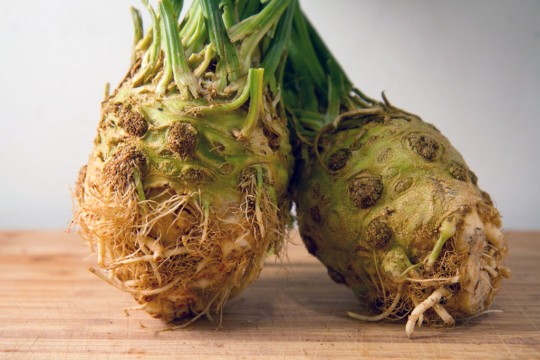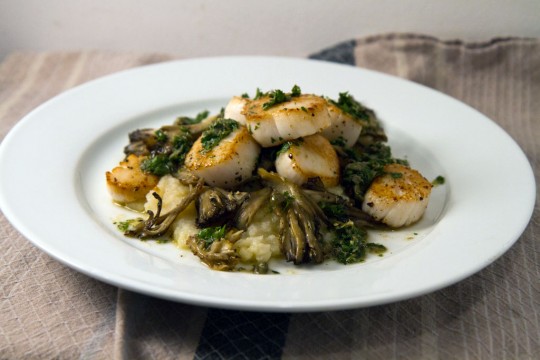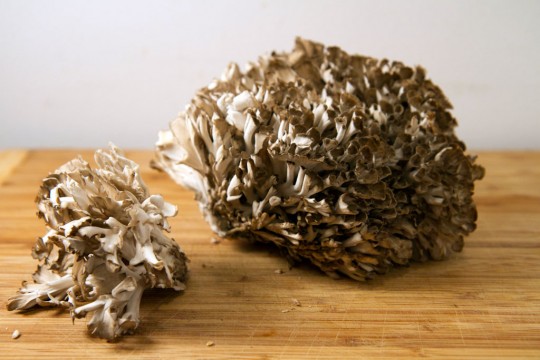Ahhh celery root. Or celeriac if you prefer. Such a wonderful fall root vegetable. It is not the root of your average celery stalk as you might think, but rather a celery plant grown for it’s edible root.

Recently I wrote about The Pasta, such an often eaten dish in our house, that when I told Brad I was working on a post about it he said, “You haven’t written about The Pasta yet?!”. Well, here’s another Thomason family favorite for you. This one is my standard weekend “date night at home” meal. We call it Fish Dinner.

Fish Dinner is a formula I regularly riff on: a base of a vegetable puree (at this time of year it’s celery root or cauliflower, but it’s always delicious with potatoes), followed by a quick sauté of either mushrooms or spinach. The star of the dish is some fresh, pan-seared Blue Moon fish, either scallops or a white fish like flounder or cod. And what seals the deal is a spoonful or two of parsley and caper relish.
On a recent evening when I chose to document Fish Dinner, I had been won over by some particularly beautiful hen-of-the-woods mushrooms at the Greenmarket. They were lovely paired with the scallops and celery root. But if I were to choose, my favorite to use in this dish would be oyster mushrooms (this is Fish Dinner after all).

Consider this more a template than a recipe. Grab yourself a nice bottle of white wine. Find the freshest fish around. And remember, the romance is in the quality of the ingredients and the dim-the-lights magic happens in the assembly.
Here’s how it goes:
- Make the parsley and caper relish and set it aside (recipe below)
- Cover your celery root/cauliflower/potatoes or root vegetable of your choosing in salted water (peeled and cut up as needed) and boil/simmer until tender, drain and puree. Stir in a bit of butter or creme fraiche if you’re feeling decadent and season with salt and pepper. Cover and set aside.
- Meanwhile, in a bit of olive oil, sauté the mushrooms or greens, seasoning lightly with salt and pepper.
- Finally, rinse and pat dry your fish and season it with salt and pepper. In a hot skillet, generously greased with olive oil, butter, or a fat of your choosing, sear the fish, turning once, until golden and just cooked through (for scallops or flounder fillets this is usually about 3 minutes per side).
- As the fish is cooking set out your plates and start to portion some of the puree. Top it with a scattering of the sautéed vegetables, then gently set the seared fish on top. Pick up your parsley and caper relish and spoon a bit over the fish and around the sides of the dish, allowing the oil to pool around the edges.
- Pour some wine, light some candles and enjoy.

Parley and Caper Relish
- Handful of parlsey, coarsley chopped (about 1/4 cup cut up)
- 1 tablespoon capers, coarsley chopped
- 3 tablespoons olive oil
- 1 lemon, zest and juice
- Salt and pepper to taste
Combine the ingredients in a bowl and allow to rest while cooking until ready to serve.
A few notes
I prefer salt-packed capers if you can find them. Just soak them briefly in a bowl of cold water and then drain.
Be careful in a multi-part dish like this not to season any of the individual parts too heavily, otherwise it’ll come together and be too salty in the end.



Stephanie says:
This is a lovely autumn combination. I love seared sea scallops but I’ve never dared to try celery root. Your recipe has inspired me to give it a try!
Heather says:
Yay! It is truly delicious. If you want to ease in, try a half potato / half celery root puree – also delicious and a fave of mine, it adds a wonderful nuttiness to your average potato mash.
Amanda says:
Mmmm this recipe looks so delicious and beautiful pictures too! Please try out my recipe for pesto stuffed mushrooms, I think you’ll like it! http://bit.ly/pestostuffedmushrooms
Thanks!
Charlie says:
Just made this tonight – fabulous! Thanks!
Heather says:
Yes! Glad you enjoyed it!
Deon Lavancha says:
Celery is a long-season crop that can be tricky to grow, some might say, the trickiest of all. It likes fertile soil, cool temperatures, and constant moisture. It will not tolerate heat and can be hard to transplant. Summer crops in the north and winter crops in the south make celery a year-round producer. All the work is worth it when you harvest crunchy, green stalks.`’…
Please do read our new blog
http://calaguastourpackage.com